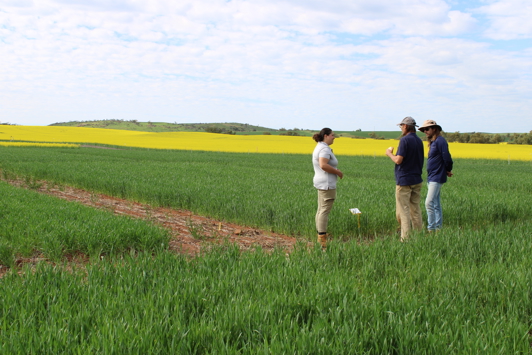The Western Australian (WA) Farming Systems project is a 5-year co-investment by the department and the Grains Research and Development Corporation (GRDC), undertaking farming systems research and development (R&D) in the medium and low rainfall regions of WA.
Using a multi-disciplinary farming systems research approach, this project will address 4 main farming systems considerations:
- system break options that deliver improved profit and acceptable risk
- a thorough analysis on the opportunities and risk of changing the timing of seeding
- analysis of management options for maintaining profitability under low greenhouse gas (GHG) emission scenarios
- incidence and severity of crown rot following diverse crop sequences, stubble breakdown, and nutritional management strategies.
The approach will include field trials, on-farm research and monitoring, grower and industry participation, and whole farm economic and biometric modelling.
Large scale system trials
The 4-year, large scale system trials were sown at three trial sites in 2023 representing different production environments across the WA grainbelt. These are:
- Medium rainfall, north – led from Geraldton with trial site located at Northampton
- Medium rainfall, south – led from Katanning with trial site located at Lake Grace
- Low rainfall - led from Merredin with trial site at the Merredin Research Station.

Trial sites use over 40 treatments to compare:
- different rotations (including wheat, lupins, canola, pasture, vetch, serradella and fallow)
- sowing times (dry vs wet)
- nitrogen rates.
Yield, soil nutrients, water use, weeds, disease and greenhouse gas emissions will be measured to compare the different rotations. Results will combine with whole farm economic modelling to address the following considerations:
- Are financial risks and/or greenhouse gas emissions reduced in WA cropping systems by reducing nitrogen inputs and diversifying rotations?
- How does water use efficiency (WUE) and nitrogen use efficiency (NUE) of cereals change relative to each other due to altered rotations, reduced fertiliser nitrogen and their interactions?
- What strategies can be used to increase profit across the rotation while managing weeds, diseases, soil fertility and risk?
-
WA Farming Systems Field Trials report 2023pdf (2.37 MB)
-
WA Farming Systems Field Trials report 2024
Supporting information
Regional Innovation Groups comprised of growers, consultants, researchers and agronomists will provide critical, ongoing input into prioritisation, refinement and confirmation of research questions and system trial treatments in each region and guide the further development of the research project.
The project will look to complement its long-term trials with relevant trials in the region. Throughout the project these will include:
- Time of sowing by species – Geraldton, Chapman Valley, Merredin, Lake Grace
- Pulse, Safflower and Chickpea legacy – Ogilvie, Merredin
- Vetch end use - Sandy Gully, Merredin, Lake Grace, Wittenoom Hills.
Modelling and analysis will play an important role in extrapolating the findings of the trials to a greater number of locations, soil types, treatments and long term climate records.
Related content
- WA Farming systems - initial findings
- Profitable, low-emission nitrogen application strategies in Western Australian dryland cropping (2023)
- Profitable, low-emission nitrogen application strategies in Western Australian dryland cropping (2024)
- Should crop sequences in Western Australia include more lupins?
- Emissions and profitability: how do nitrogen and lime affect both?
- On the case of low-emission crop rotations
- Comprehensive strategies to enhance western farming systems
- Species by time of sowing trial in Chapman Valley
- Initiation of a farming systems trial series in Western Australia
- Improving farming system profitability, management of greenhouse gas emissions and climate resilience in the low and medium rainfall zones of WA: Grower Perspectives

Acknowledgments
The WA Farming Systems project (DAW2204-003RTX) is a 5-year co-investment by the Department of Primary Industries and Regional Development and the Grains Research and Development Corporation.
Contact us
-
Megan Abrahams

